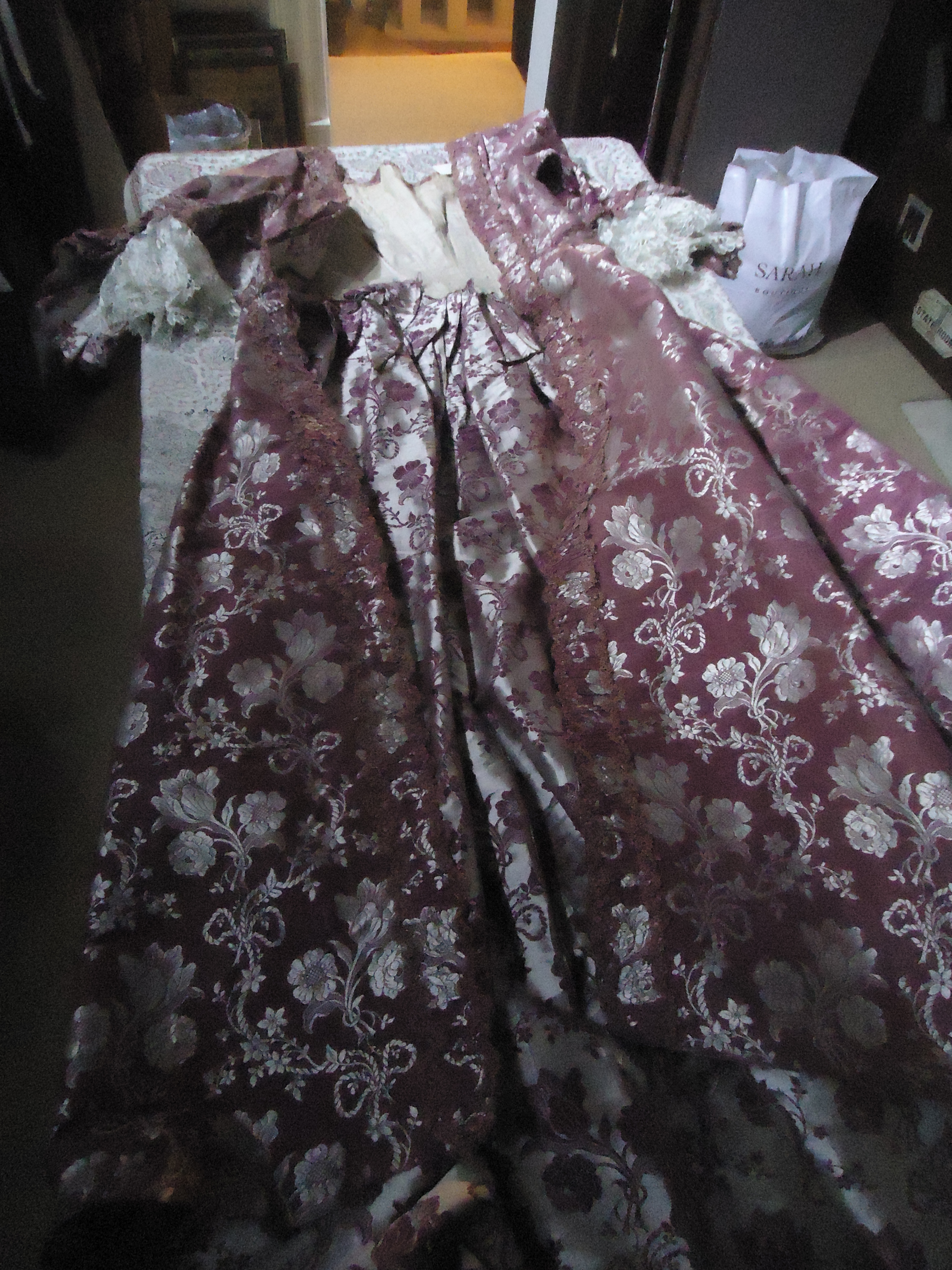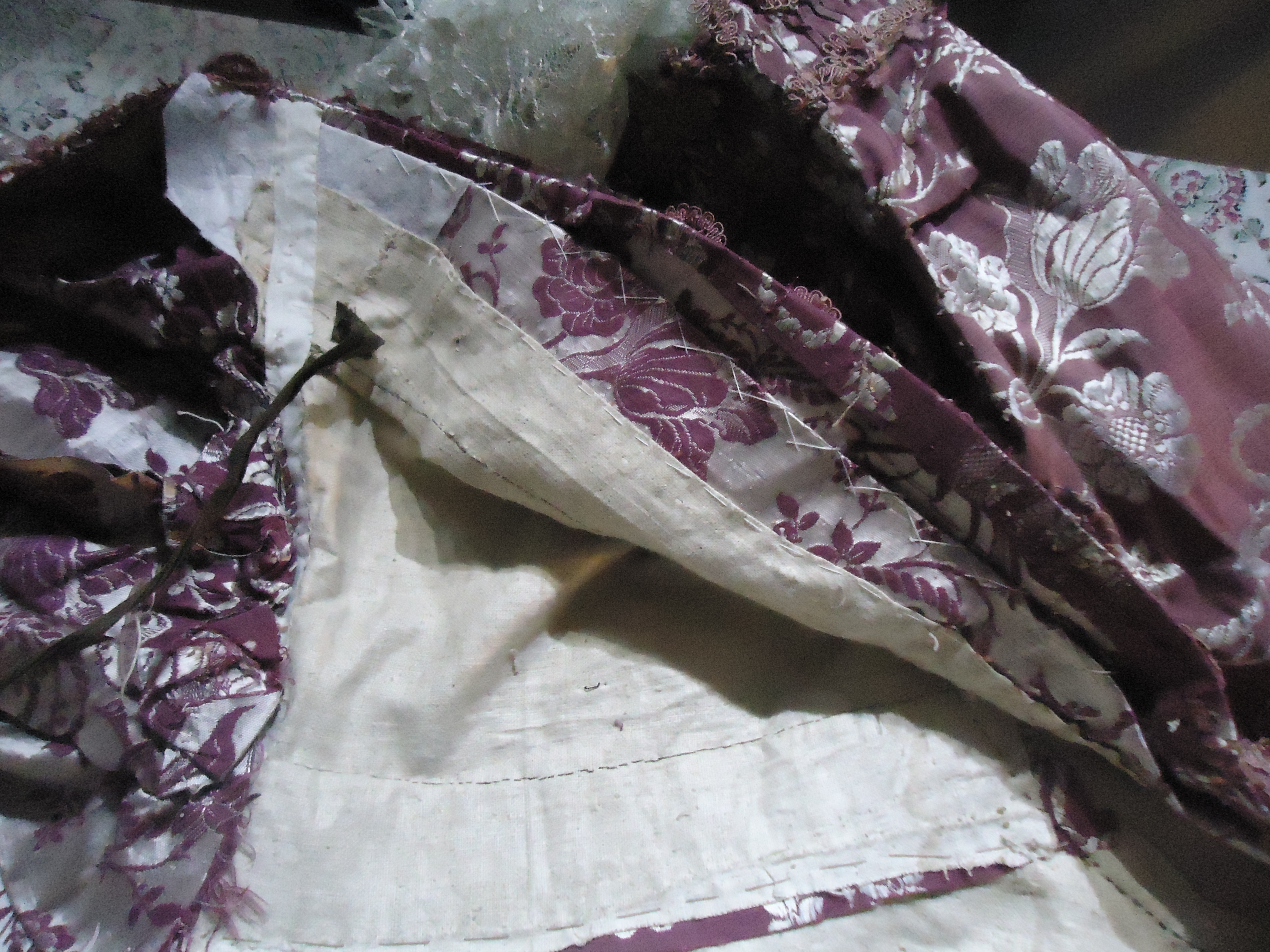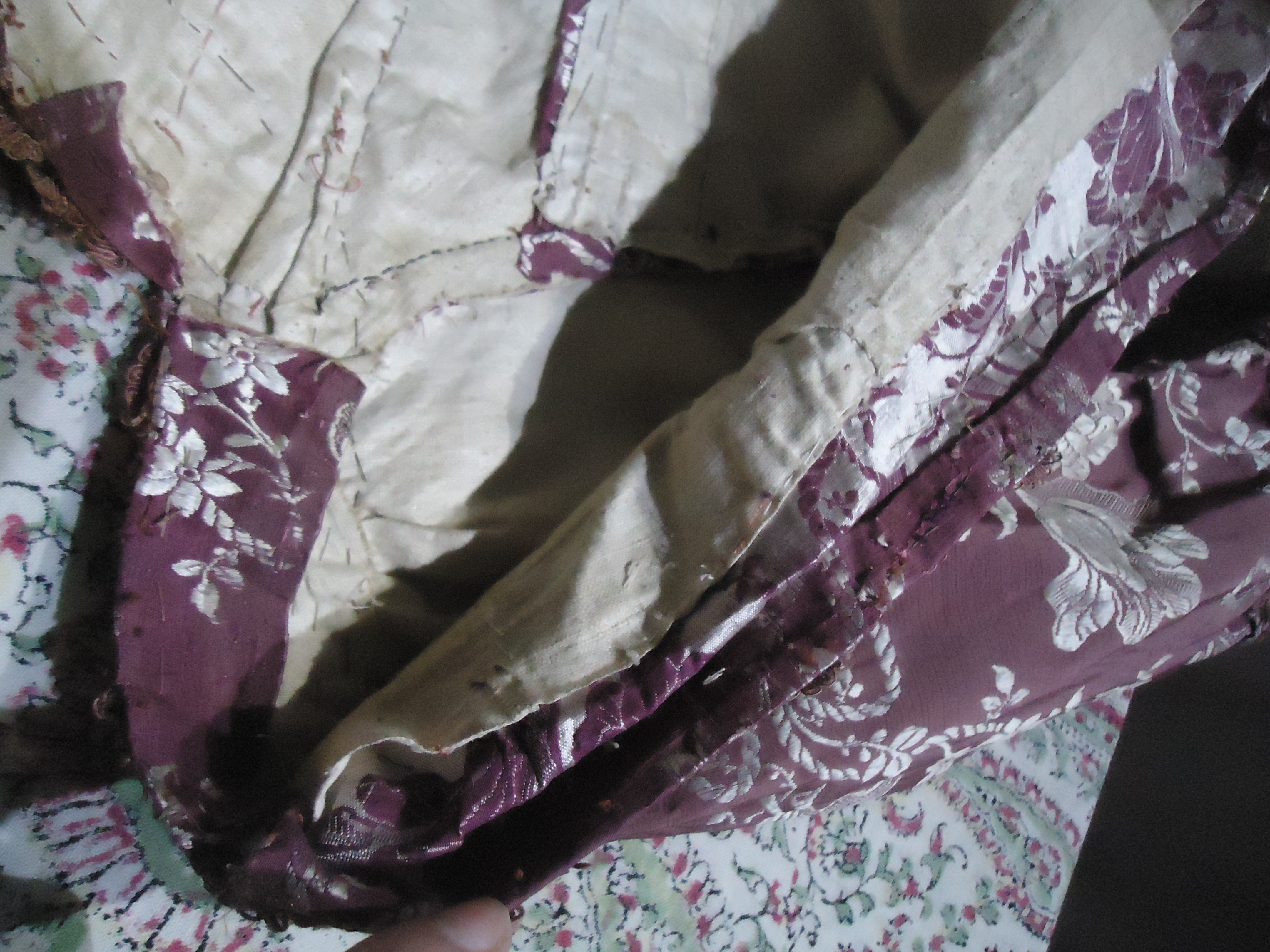Totnes Fashion Museum
(All Photos Courtesy of the Totnes Fashion Museum)
I had the most amazing day with Julia Fox at the Totnes Fashion Museum when they were changing their displays. From a prior phone call she had 3 dresses waiting to be dressed onto their mannequins that she’d held out for me and they were wonderful. I learnt so much that day.
For starters watching Julia and her colleague dress the mannequins was fascinating enough, layering up with Hip Pads  and Underskirts and pinning the stomachers in place. Julia spoke so interestingly about how ladies were pinned in to their dresses, each pin artfully hidden beneath the robings, and how the tie at the CB of the dresses was so incredibly practical as it held in the back waist nice and tight and tied over the stays to the front and then was hidden by the stomacher. There were so many questions that I didn’t even realise I had that were just answered as she talked through they dressing process and cultural habits at the time. I have often wondered if it was a fashion phase that made ladies appear with their robings flapping as you can see it depicted in, not only in scened and cartoon paintings but in portraits as well. Hogarth’s ‘The Countess Levee’ in the Marriage a la Mode series is one example where the younger lady has her dress gaping wide open. But Julia Fox explained how during this period, the lengthy dressing programme they had to do each day became a form of Undress. I’ve certainly read many times how they held appointments in these times and held audiences. Iris Brooke in her book ‘Dress and Undress’ quotes from an account of a social function which the writer had attended where the Hostess was sitting before her mirror and applying patches (page 72). There are certainly a fair few engravings with it seems the lady is in her shift with her bust virtually exposed, chatting happily while her maid
and Underskirts and pinning the stomachers in place. Julia spoke so interestingly about how ladies were pinned in to their dresses, each pin artfully hidden beneath the robings, and how the tie at the CB of the dresses was so incredibly practical as it held in the back waist nice and tight and tied over the stays to the front and then was hidden by the stomacher. There were so many questions that I didn’t even realise I had that were just answered as she talked through they dressing process and cultural habits at the time. I have often wondered if it was a fashion phase that made ladies appear with their robings flapping as you can see it depicted in, not only in scened and cartoon paintings but in portraits as well. Hogarth’s ‘The Countess Levee’ in the Marriage a la Mode series is one example where the younger lady has her dress gaping wide open. But Julia Fox explained how during this period, the lengthy dressing programme they had to do each day became a form of Undress. I’ve certainly read many times how they held appointments in these times and held audiences. Iris Brooke in her book ‘Dress and Undress’ quotes from an account of a social function which the writer had attended where the Hostess was sitting before her mirror and applying patches (page 72). There are certainly a fair few engravings with it seems the lady is in her shift with her bust virtually exposed, chatting happily while her maid
 dresses her but I can only think that this would be family only. But it is well known that the term ‘Undress’ was a valid day wear that originated from the more comfortable clothes worn at home.
dresses her but I can only think that this would be family only. But it is well known that the term ‘Undress’ was a valid day wear that originated from the more comfortable clothes worn at home.
This Red Dress that features in these photos was a Robe a l’Anglais and features the typical sewn down pleats at the centre
back that they flow into the back of the skirt. If you look at this image closely you can see the inside of this pleats training straight down from the bodice and from under the lining. Please forgive the light, in order to protect the costumes they have special lighting and obviously these photo’s were taken without using a flash. But if you ignore the dullness you can still see plenty the details needed to be gleaned from such dresses.
Details of Red Dress:
– Robe a l’Anglais
– Lined Bodice
– Wider Robings that Furbelows
– Furbelows coming down from Robings and straight along CF edge of Skirt.
– Frilled Cuffs.
– Furbelows edged with Fly trim.
– Robings fold Herringboned Stitched down.
– 1/4 Inch raw selvedge seams.
– Front Bodice with dart.
– Furbelows sewn down with a stab stitch.
– Petticoat has a curved hemmed Trim.
I obviously had a relatively short time and between taking photo’s, helping hold doors open and taking super-quick sketches, there wasn’t really loads of time for taking measurements and such.
I’m going to include my rather bad sketches of each dress aswell as it may help complete the picture and I dare anyone to be able to read my scribbled notations. When I sketch I always think, ‘this drawing is not so important: I have the photos as the main records’ but then when I see the photos I think ‘what I need is my drawings with all the notes arrowed in’. But may you find both useful. 
– This next image is a close-up of the top of the Bodice and shoulder including a detailed shot of the Furbelow and Fly Trim. You can see the stitching even from this photo, see how the Fly Trim has been gathered up and set into curves – It’s like they’ve pulled one thread and then held it into place by catching it down. And see the barely-gathered Furbelow, the centre run of stitching and other stabbed stitches holding it in place. these Stab Stitches were done from the other side, creating a large running stitch on one side and barely noticeable pricks of a stitch on the other. The way we learnt it at the Tailor’s was you had your hand on the Right Side of the garment (tiny stitch side) and you sewed into your finger almost, using the cushion of your finger tip to tell you how far you had come out. It is the same technique used in Padstitching collars. You can also see from this image the stitching used to hold down the CB Pleats typical of Robe a l’Anglais. This is a clear example of the stitching just mentioned above as the running stitch that we see here is coming out the other side as a tiny catching of the fabric.
You can see here from the above image how the robings have been sewn down. This in itself is an amazing example of both how logical the Eighteenth Century Tailoring was but also how practical and functional. You can see in this particular dress that it was a) Grown on and b) folded to the right specification and held there by the herringbone stitch and c) alos only had a small turn back for the centre front facing. The lining doesn’t even come up to it! You just see this bare fabric turned back with what could seem like a sloppy raw edge. From a previous trip to the Totnes Fashion Museum, Julia Fox had said something that just clicked so much into place for me when looking at eighteenth century dresses. She said the reason why they left the additional corners of fabric that they didn’t need, for example, in the pleating curve of the front fall of the skirt, was that if the dress was unpicked and ironed back out flat, there would still be as much as possible large squares of the original fabric. This meant that you could much more easily re-make it or use it for a different purpose. To me, that’s just wonderfully logical. This logic could be followed through into the grown-on robings and the way the sacks were sewn down but kept in the Robe a l’Anglais’. You can see some of this raw edge, excess fabric in the gathered section of the skirt in the above image. It’s not there in abundance but the amount of what we would call ‘seam allowance’ in the seam of pleats is clearly large, raw and fraying only just slightly after 200 years. Nowadays this would’ve been cut to each pleat and overlocked off and hidden by the lining.
This image above here may look upside down and it probably is, but the whole detail of it is looking down from the top right hand corner of the dress, down into the front robing that is being held out by the finger, but also down into the back section of the dress and seeing the shoulder band, the sleeve lining and the scye seams. There are many interesting details in this photo. You can see the pin holes from pinning down the robings travelling along the inside of the cf Robing as held out by the finger. You can see clearly the large tacks that were holding down the furbellow trim, and the amount of what looks like random large stitches in the sleeve lining of the crown and the lining of the back. These stitches weren’t arbitrary. Modern day tailoring has been developed to hide as much of the inner workings as possible. Less visible stitching has been encouraged when sewing in a way that will be seen, and the lining has been designed to hide as much of it as possible. It’s hard to look at stuff like this and not think it was a rushed job, or that they were being sloppy. And it’s hard for us when trying to replicate a garment for selling, to not use these newer techniques for the neatness of our garments – we know we do it here at HandBound. A part of me would like to work through the same sewing process they worked through and experience it. There’s always so much more research to do! A part of me loves the idea of making up a garment completely using their techniques and beholding the raw edginess of it all in all it’s glory.





